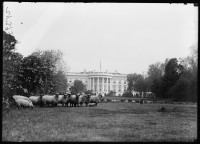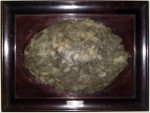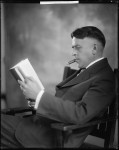 After President Woodrow Wilson declared war on Germany in April of 1917, his own family undertook to set an example of home front contributions to the war effort. Following the programs of future president Herbert Hoover, then head of the Food Administration, Woodrow’s wife Edith instituted fuel and food conservation measures like gasless Sundays, meatless Mondays and wheatless Wednesdays. They suspended White House entertaining and worked assiduously to raise money for the troops by organizing liberty bond rallies hosted by the likes of Charlie Chaplin, Douglas Fairbanks and Mary Pickford.
After President Woodrow Wilson declared war on Germany in April of 1917, his own family undertook to set an example of home front contributions to the war effort. Following the programs of future president Herbert Hoover, then head of the Food Administration, Woodrow’s wife Edith instituted fuel and food conservation measures like gasless Sundays, meatless Mondays and wheatless Wednesdays. They suspended White House entertaining and worked assiduously to raise money for the troops by organizing liberty bond rallies hosted by the likes of Charlie Chaplin, Douglas Fairbanks and Mary Pickford.
In 1918, they took that commitment to a whole new level of cuteness. Wilson purchased a flock of 18 sheep led by an ornery ram named Old Ike who was famous for chewing tobacco. He gnoshed on any cigar butt he could find. He was no fan of humans — White House staff and police were favorite targets for his head-butting wrath — but he was a fine leader of ewes and produced a mighty fleece.
( Interestingly, he wasn’t the first vicious ram to roam the White House lawns. Thomas Jefferson brought a large flock with him from Monticello in 1807 to continue the breeding program he had long been obsessed with. The leader of the flock was a four-horned Shetland ram who took aim at anyone attempting to take a short cut through the property back when that sort of thing was possible. In 1808 he felled William Keough, a Revolutionary War veteran who had fallen on hard times and was in Washington, D.C. to petition the President for a pension. Others were not so lucky. The ram actually killed a child. When he returned to Monticello, he killed two other rams and one of his own offspring. Finally in 1811 Jefferson had him put down.)
Interestingly, he wasn’t the first vicious ram to roam the White House lawns. Thomas Jefferson brought a large flock with him from Monticello in 1807 to continue the breeding program he had long been obsessed with. The leader of the flock was a four-horned Shetland ram who took aim at anyone attempting to take a short cut through the property back when that sort of thing was possible. In 1808 he felled William Keough, a Revolutionary War veteran who had fallen on hard times and was in Washington, D.C. to petition the President for a pension. Others were not so lucky. The ram actually killed a child. When he returned to Monticello, he killed two other rams and one of his own offspring. Finally in 1811 Jefferson had him put down.)
Wilson’s White House sheep released groundskeeping personnel so they could enlist, saved money on maintenance and raised money through wool sales. Here’s some footage of the flock trundling around the Executive Mansion grounds while Woodrow Wilson looks out the window at them.
[youtube=http://youtu.be/n6nhqFIIGR4&w=430]
The White House lawns turned out to make outstanding pasture land. The sheep feasted mightily on the sweet grasses, growing thick woolen pelts and making lots of adorable lambs to increase their numbers. They kept the lawns manicured and fertilized, and much like White House pets today, were widely popular with the American public. The sheep were also fundraisers of unparalleled efficacy. The animals with the best quality fleece were sheered and their wool sold at auction. The states each received a few fleeces to be auctioned off with the imprimatur of White  House Wool. The first sale in 1918 raised $30,000 for the Red Cross. The next year’s auction raised an extraordinary $52,823 for the Red Cross, an average of $1,000 a pound. To this day it remains the most expensive wool ever sold. Ike’s fleece, incidentally, sold for a mind-blowing $10,000 a pound.
House Wool. The first sale in 1918 raised $30,000 for the Red Cross. The next year’s auction raised an extraordinary $52,823 for the Red Cross, an average of $1,000 a pound. To this day it remains the most expensive wool ever sold. Ike’s fleece, incidentally, sold for a mind-blowing $10,000 a pound.
 The sheep outlasted the war. Newspapers reported that more than half the flock of 46 was sheered on May 24th, 1920, both to raise money for charity and to keep the sheep looking sharp so they didn’t mar the handsome prospect of the Pennsylvania Avenue-fronting North Lawn. That year 185 pounds of wool were sheered from the White House flock and donated to the Salvation Army. There were two more head in the flock by August when the White House sheep were decommissioned because the Shepherd in Chief had failed to secure the nomination of his party at the 1920 Democratic National Convention the month before.
The sheep outlasted the war. Newspapers reported that more than half the flock of 46 was sheered on May 24th, 1920, both to raise money for charity and to keep the sheep looking sharp so they didn’t mar the handsome prospect of the Pennsylvania Avenue-fronting North Lawn. That year 185 pounds of wool were sheered from the White House flock and donated to the Salvation Army. There were two more head in the flock by August when the White House sheep were decommissioned because the Shepherd in Chief had failed to secure the nomination of his party at the 1920 Democratic National Convention the month before.
 The flock retired to the Maryland farm of Lionel C. “Dick” Probert, chief of the Washington bureau of the Associated Press, who had himself played a pivotal but virtually unknown role in the United States’ entry into World War I. It was Probert who broke the story of the Zimmermann Telegram, the coded message sent by German Foreign Minister Arthur Zimmermann to the German Ambassador to Mexico, Heinrich von Eckhardt, instructing him to offer Mexico funding and territories in the US if it joined the war on the German side. The AP story, written without byline by Probert, went to press on March 1, 1917. It was a sensation, inciting widespread anti-German feeling all over the country. A month later, the US was at war with Germany.
The flock retired to the Maryland farm of Lionel C. “Dick” Probert, chief of the Washington bureau of the Associated Press, who had himself played a pivotal but virtually unknown role in the United States’ entry into World War I. It was Probert who broke the story of the Zimmermann Telegram, the coded message sent by German Foreign Minister Arthur Zimmermann to the German Ambassador to Mexico, Heinrich von Eckhardt, instructing him to offer Mexico funding and territories in the US if it joined the war on the German side. The AP story, written without byline by Probert, went to press on March 1, 1917. It was a sensation, inciting widespread anti-German feeling all over the country. A month later, the US was at war with Germany.
The White House sheep continued to thrive at Probert’s farm. By 1927, the year Old Ike shuffled off this mortal coil, the flock had increased to 75 head.